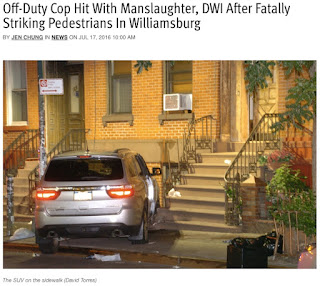This Just In: Motor Vehicles May Be Dangerous
Not to get too heavy on a Monday morning, but the following tweets appeared side-by-side in my Twitter timeline over the weekend and it's been on my mind ever since:
The truck, he said, displayed no unusual menace but upset him all the same as heavy vehicles are supposed to be banned from the sedate residential area at that hour. Moreover, it was moving in the wrong direction down the one-way street outside his apartment.
Meanwhile, truckers operating illegally on residential streets is a typical day in New York City, but the NYPD only tickets them after they've already killed someone--and even then they only do so after they've exhausted all other victim-blaming possibilities:
Gregg was killed on April 20 by a tractor-trailer driver on Sixth Avenue near Sterling Place. That’s not a truck route, and based on photos of the scene, there is a strong possibility the truck that hit Gregg was too long to be operated legally on NYC surface streets. But an officer at the scene suggested Gregg had acted recklessly by trying to hitch a ride, which also describes what a cyclist desperately trying to fend off an oversized truck might look like. NYPD later said Gregg “for unknown reasons fell to the ground,” and eventually ticketed the trucker for equipment violations driving off-route, but he was not charged by police or District Attorney Ken Thompson for taking Gregg’s life.
And all of this is to say nothing of the fact that terrorists used a truck for the first World Trade Center attack way back in 1993, and attempted to blow up Times Square with a car in 2010. So again: How is the threat posed by trucks in any way new? Meanwhile, we remain so resistant in New York City to the idea that motor vehicles make great weapons that we refuse to accept anything we perceive as a threat to our "right" to unfettered motordom (congestion pricing, speed cameras, and of course those hated bike lanes)--though you can't really blame us, since of course cyclists are the real terrorists.
In short, if we do so little to protect ourselves from the drivers who kill by "accident" then what chance do we have against a driver who decides to kill on purpose? Because even when someone attacks you with their car and you report them to the police here's what happens:
So there you go.
And as for that off-duty cop, he has been charged, though it's horrifying to consider what you have to do with your car to actually get in trouble in this town:
Witnesses say that Batka, who was scheduled to be on-duty at 7 a.m., flashed his NYPD badge and apparently asked cops, "Did I kill anybody?" when they arrived.
Angie Zielenski described the chaos to WABC 7, "I see this girl lying on the floor, so I lift her head up because she was bleeding from her head and her leg. I ran across the street, and I called 911, and the driver jumped from the driver's side to the passenger side, and there was a man who was holding the door of the SUV shut to not let him out."
Had he not succeeded in hitting anybody no doubt it would have been another case of "there's nothing we can do."
Meanwhile, in lighter news, the Times also takes a sartorial look at the Tour de France, and it should come as a surprise to nobody that Mario Cipollini gets a mention:
Cycling’s most extreme fashion rebel was Mario Cipollini, an Italian sprinter who was at his peak during the 1990s. He generated as much attention for his sponsors with what he wore as he did with what he won. He once turned up for a Tour stage in a chariot wearing vaguely Roman-styled cycling clothes underneath a toga. Perhaps his most extreme sartorial selection was an aerodynamic skin suit that was patterned with a life-size, anatomical drawing of muscles.
It's true, Cipo made Peter Sagan look like a total dweeb:
I was also amused to note that Tinkoff is the most anal-retentive team in the peloton when it comes to clothing:
Some teams, like Tinkoff, impose a dress code that even the Marine Corps might admire.
Yates said that Tinkoff riders must be dressed identically at all times in every race. The edict is carried to some extreme limits. The team has two styles of shorts that, at a casual glance, appear identical. But one is made from a heavier fabric, which some riders find warmer and more comfortable in the rain.
Despite their similar appearance, Yates said, the team forbids mixing the two styles within a race. So the riders take a vote to make a selection.
Indeed, when it comes to voting and shorts, you can always count on one man to abstain:
The aforementioned Times article calls trucks a "frightening new landscape of terrorism." As a New Yorker, I'm dismayed to hear this threat described as "new," given how successfully we've been terrorizing ourselves with cars and trucks and things that go for the past 100 years without even trying. Consider also:Thought-provoking juxtaposition. pic.twitter.com/ZBlJSKvaFV— Bike Snob NYC (@bikesnobnyc) July 16, 2016
The truck, he said, displayed no unusual menace but upset him all the same as heavy vehicles are supposed to be banned from the sedate residential area at that hour. Moreover, it was moving in the wrong direction down the one-way street outside his apartment.
Meanwhile, truckers operating illegally on residential streets is a typical day in New York City, but the NYPD only tickets them after they've already killed someone--and even then they only do so after they've exhausted all other victim-blaming possibilities:
Gregg was killed on April 20 by a tractor-trailer driver on Sixth Avenue near Sterling Place. That’s not a truck route, and based on photos of the scene, there is a strong possibility the truck that hit Gregg was too long to be operated legally on NYC surface streets. But an officer at the scene suggested Gregg had acted recklessly by trying to hitch a ride, which also describes what a cyclist desperately trying to fend off an oversized truck might look like. NYPD later said Gregg “for unknown reasons fell to the ground,” and eventually ticketed the trucker for equipment violations driving off-route, but he was not charged by police or District Attorney Ken Thompson for taking Gregg’s life.
And all of this is to say nothing of the fact that terrorists used a truck for the first World Trade Center attack way back in 1993, and attempted to blow up Times Square with a car in 2010. So again: How is the threat posed by trucks in any way new? Meanwhile, we remain so resistant in New York City to the idea that motor vehicles make great weapons that we refuse to accept anything we perceive as a threat to our "right" to unfettered motordom (congestion pricing, speed cameras, and of course those hated bike lanes)--though you can't really blame us, since of course cyclists are the real terrorists.
In short, if we do so little to protect ourselves from the drivers who kill by "accident" then what chance do we have against a driver who decides to kill on purpose? Because even when someone attacks you with their car and you report them to the police here's what happens:
So there you go.
And as for that off-duty cop, he has been charged, though it's horrifying to consider what you have to do with your car to actually get in trouble in this town:
Witnesses say that Batka, who was scheduled to be on-duty at 7 a.m., flashed his NYPD badge and apparently asked cops, "Did I kill anybody?" when they arrived.
Angie Zielenski described the chaos to WABC 7, "I see this girl lying on the floor, so I lift her head up because she was bleeding from her head and her leg. I ran across the street, and I called 911, and the driver jumped from the driver's side to the passenger side, and there was a man who was holding the door of the SUV shut to not let him out."
Had he not succeeded in hitting anybody no doubt it would have been another case of "there's nothing we can do."
Meanwhile, in lighter news, the Times also takes a sartorial look at the Tour de France, and it should come as a surprise to nobody that Mario Cipollini gets a mention:
Cycling’s most extreme fashion rebel was Mario Cipollini, an Italian sprinter who was at his peak during the 1990s. He generated as much attention for his sponsors with what he wore as he did with what he won. He once turned up for a Tour stage in a chariot wearing vaguely Roman-styled cycling clothes underneath a toga. Perhaps his most extreme sartorial selection was an aerodynamic skin suit that was patterned with a life-size, anatomical drawing of muscles.
It's true, Cipo made Peter Sagan look like a total dweeb:
I was also amused to note that Tinkoff is the most anal-retentive team in the peloton when it comes to clothing:
Some teams, like Tinkoff, impose a dress code that even the Marine Corps might admire.
Yates said that Tinkoff riders must be dressed identically at all times in every race. The edict is carried to some extreme limits. The team has two styles of shorts that, at a casual glance, appear identical. But one is made from a heavier fabric, which some riders find warmer and more comfortable in the rain.
Despite their similar appearance, Yates said, the team forbids mixing the two styles within a race. So the riders take a vote to make a selection.
Indeed, when it comes to voting and shorts, you can always count on one man to abstain:
This Just In: Motor Vehicles May Be Dangerous
 Reviewed by Animatrix
on
8:46:00 AM
Rating:
Reviewed by Animatrix
on
8:46:00 AM
Rating:
 Reviewed by Animatrix
on
8:46:00 AM
Rating:
Reviewed by Animatrix
on
8:46:00 AM
Rating:







No comments: